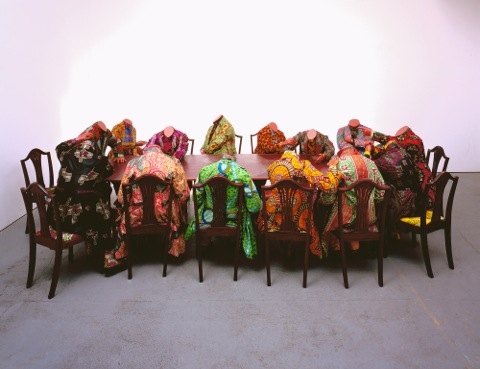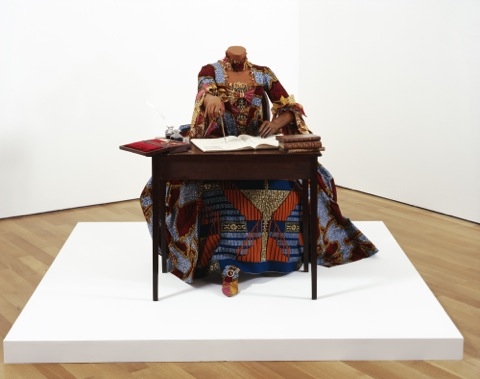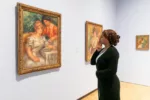[Leah reviews sculptural work by Yinka Shonibare that connects past societal norms to the present, focusing on big ideas like colonialism and perception of gender and disability — the Artblog editors]
Yinka Shonibare’s Magic Ladders, currently on view at the Barnes Foundation, treads on new territory for the Barnes on the Parkway. For this contemporary art show, the foundation commissioned new works by Shonibare. It’s the first work the Barnes has commissioned since 1932, when it tasked Henri Matisse with making his famous site-specific mural, “The Dance II“. With this new commission, the Barnes seems to be picking up where Albert Barnes left off, adding new work into the building that houses its historic art ensembles.
Examining our place in history

Albert Barnes died in 1951 and the British-Nigerian Shonibare was born in 1962, but they both share(d) a passion for education and books. The three works that Shonibare was commissioned to make for Magic Ladders all feature books: sculptural facsimiles of books in Albert Barnes’ library. The big, encyclopedia-like books (for example, Exposition de l”Art Italien de Cimabue a Tiepolo, Lebanon County Through the Centuries, Dessins de Litterateurs 1926) are both physical and figurative steps on a ladder that leads to higher education and understanding of the world. Climbing on the ladders are mannequins of children dressed in Victorian-era clothing. The children, whose heads are black globes instead of human heads, are the physical and figurative stand-ins for those who will succeed.
The three ladders are a fraction of the 17 total works featured in the big show. The exhibition walks the viewer through a brief history of Shonibare’s work between 1996-2013. Among the righteous themes Shonibare raises are colonialism, racism, difference, his unique experience, enlightenment, and patriarchal society’s place in history as well as contemporary society.
One sculptural installation called “Scramble for Africa,” created in 2003, features 14 headless figures representing 14 colonial nations. These figures are gesturing pointedly and arguing while sitting around a grand table that depicts a map of Africa. The colonial nations are divvying up the continent of Africa.

Another piece called “The Age of Enlightenment,” made in 2008, features three historical figures–Antoine Lavoisier, the Marquise du Chatelet, and Immanuel Kant. These figures are wearing period garments (17th-18th century) and working on various creative scientific and mathematical pursuits of the era. Like most Shonibare figures, they are headless, have an ambiguous skin tone, and sport Victorian-esque clothes in traditional fabric (Dutch wax-printed cotton) which has an African aesthetic, although it is actually produced in Europe. Each figure has a disability. Lavoisier sits in a wheelchair, the Marquise du Chatelet has a wooden arm, and Kant has no legs.

Challenging viewer expectations
As if he’s the official gallery greeter, the towering “Big Boy,” which was made in 2002, seems to stride towards the viewer who enters the gallery. This large sculpture–84” high on a round, 12”-tall platform–is both overbearing and seductive at the same time. The figure is meant to be a “Victorian dandy”. Although the mannequin has a masculine build, it also features breasts, and is dressed in elaborate clothing including both male and female items. This work pushes the viewer to consider race, gender, and placement of one’s self as well as others in society.

Shonibare’s work does its duty of questioning the artistic, historical, and intellectual politics of Europe. Through an exploration of his own identity, Shonibare is able to awaken the viewer’s understanding of his or her own circumstance and experience.
Sometimes, he does this through playful gestures, like depicting schoolchildren enacting the human experience of cheating at school work in “Pedagogy Boy/Boy,” from 2003. It’s possible to see this piece, which features two children sitting at a common desk, one leaning over the other, as being about an act of tutoring, but the ambiguity of whether there is cheating or helping going on raises all kinds of interesting issues related to learning and education.
Shonibare challenges viewer expectations through his figures’ ambiguity and differences. These shifts in expectation culminate in the viewers’ minds while they try to decide what they individually find appropriate or ideal.
Your mileage may vary
Although these ideas are seamless and accessible, and for that matter, executed beautifully, I thought they bordered on being too easy. Shonibare’s message comes through right away, and is additionally provided to the viewer in a concise manner through the wall texts accompanying each piece. This direct feed of information guides the viewer and leaves her with less room for contemplation, followed by a momentary appreciation for the formal qualities. Overall, this results in viewers “getting it” quickly and moving on. This “a-ha!” experience is very attractive to many viewers, especially the museum-goer who does not want to be left feeling stupid and/or confused.
I find Shonibare’s work to be somewhat of a quick read, but I do not find his concepts to be shallow in any sense of the word. I conclude that for the museum-going audience who visits to receive an education, this work has an appropriate pace. Each viewer can take away the artist’s intense ideas and contemplate them for as much or little time as they wish.
Ironically, Shonibare’s work is so pleasing and easy to look at, I find myself getting visually lost, which leaves me with a bit more time to meditate on the concepts behind each piece, as well as the themes connecting his body of work.
The author would like to thank Andrew Stewart for speaking to her about the show, and also give a shout-out to the beautiful Yinka Shonibare MBE Magic Ladders catalog.
Magic Ladders is on view at the Barnes Foundation, and can be seen until April 21st, 2014.









